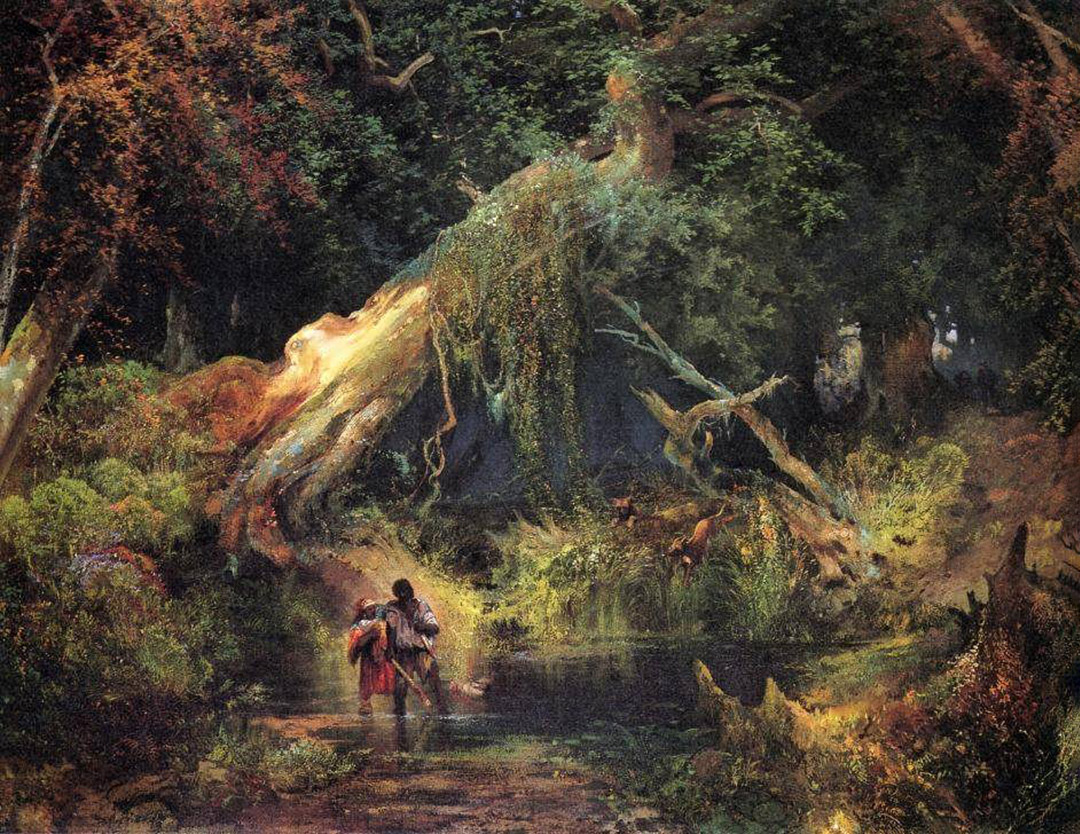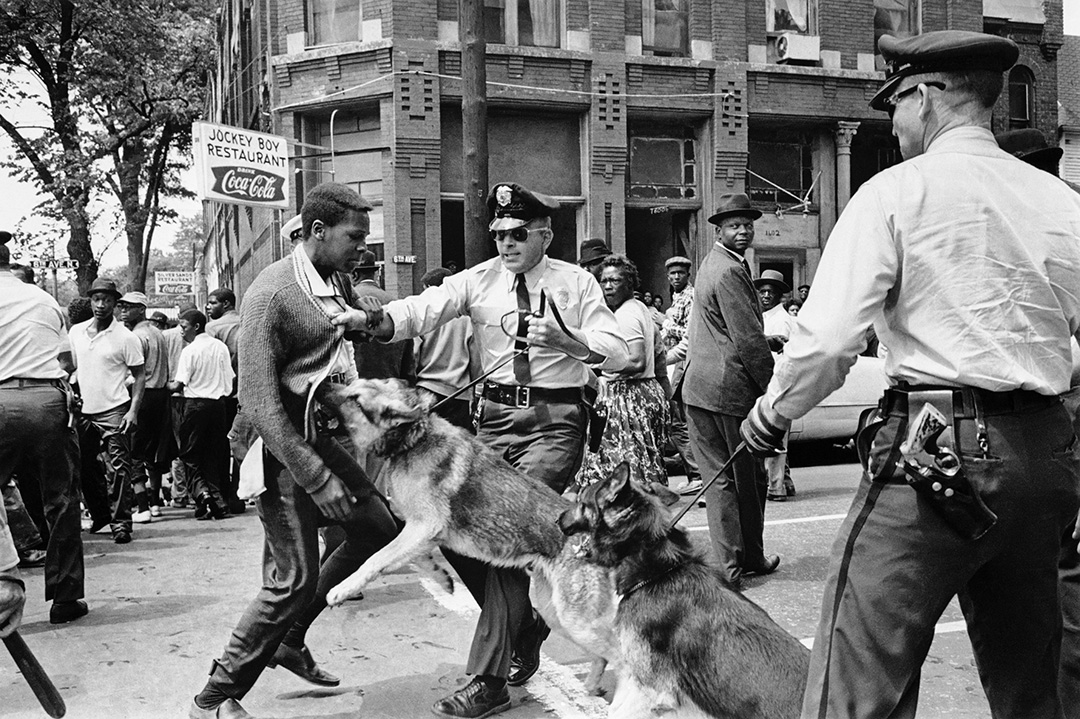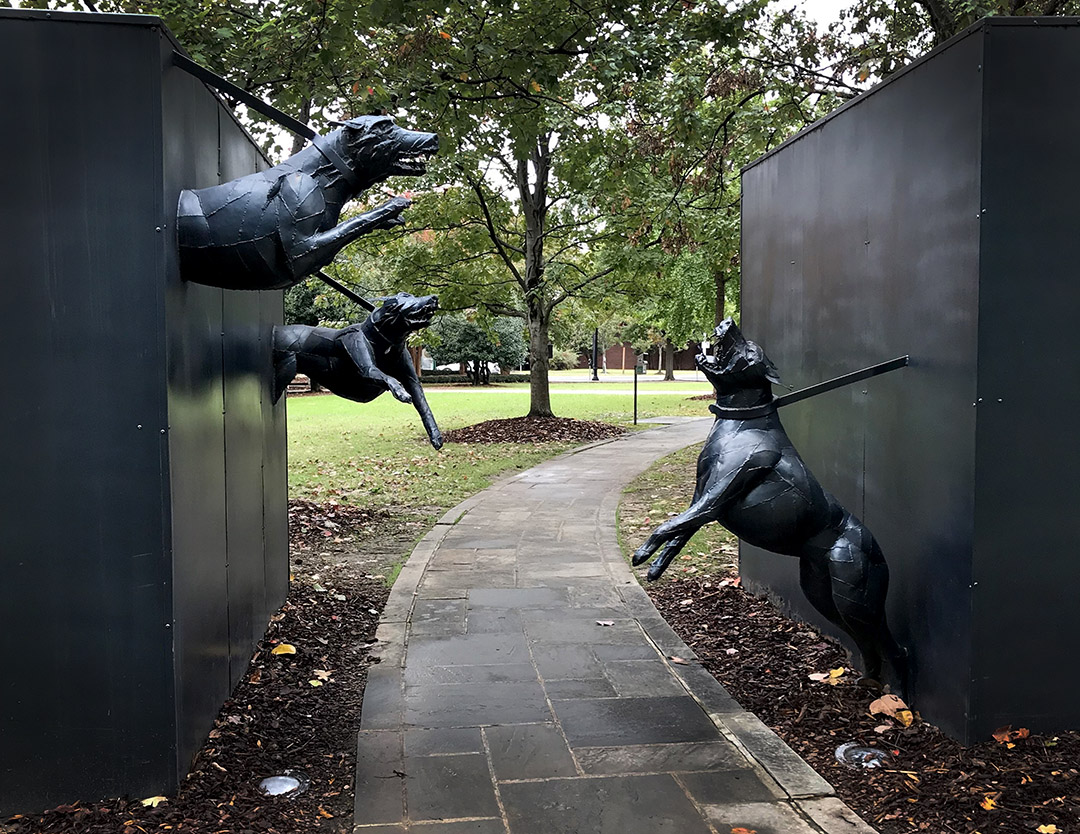PALIMPSESTS
Violence and Injury
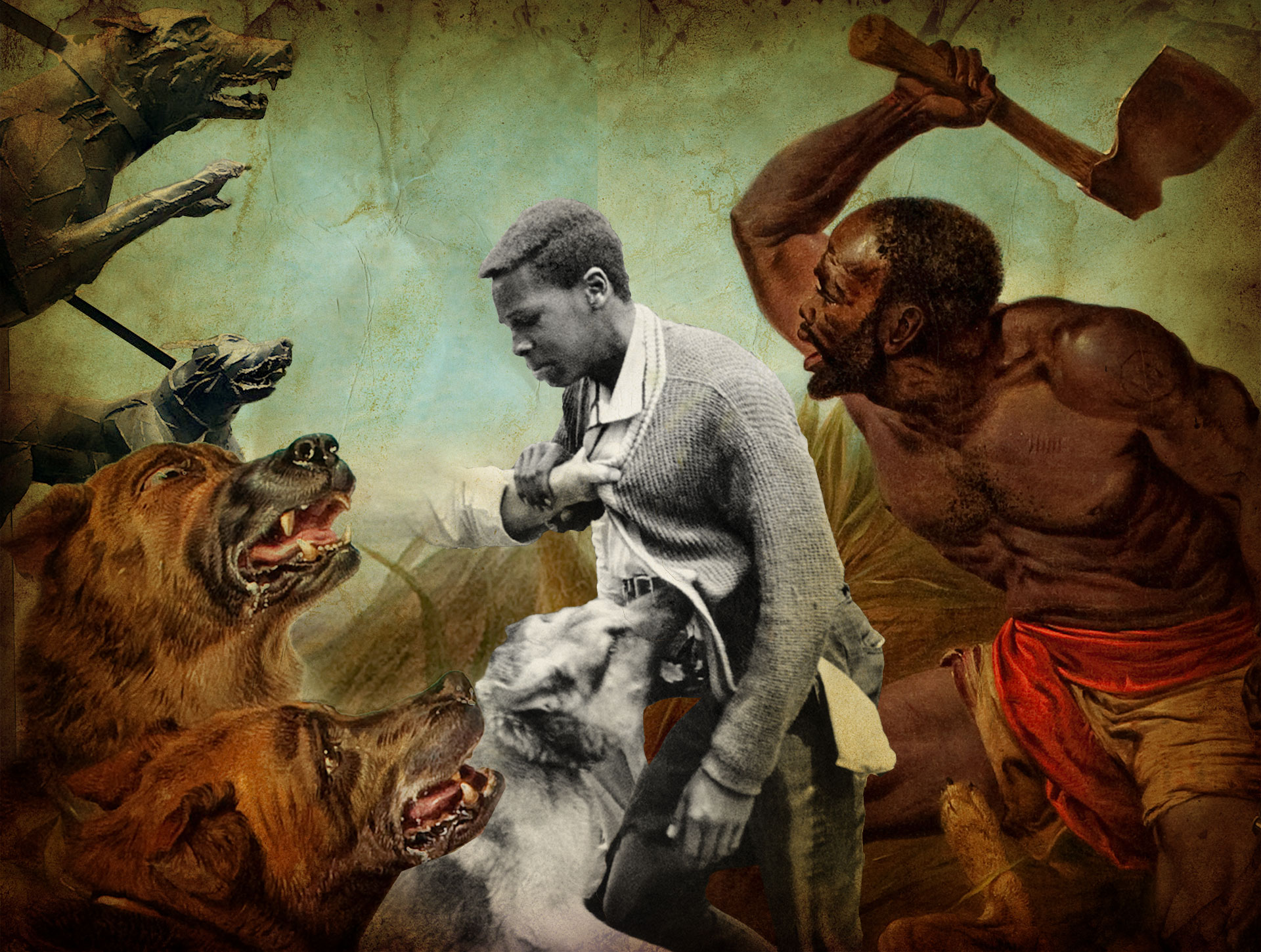
Dogs
by Agnes Lugo-Ortiz
A palimpsest on policing, animality, and Blackness
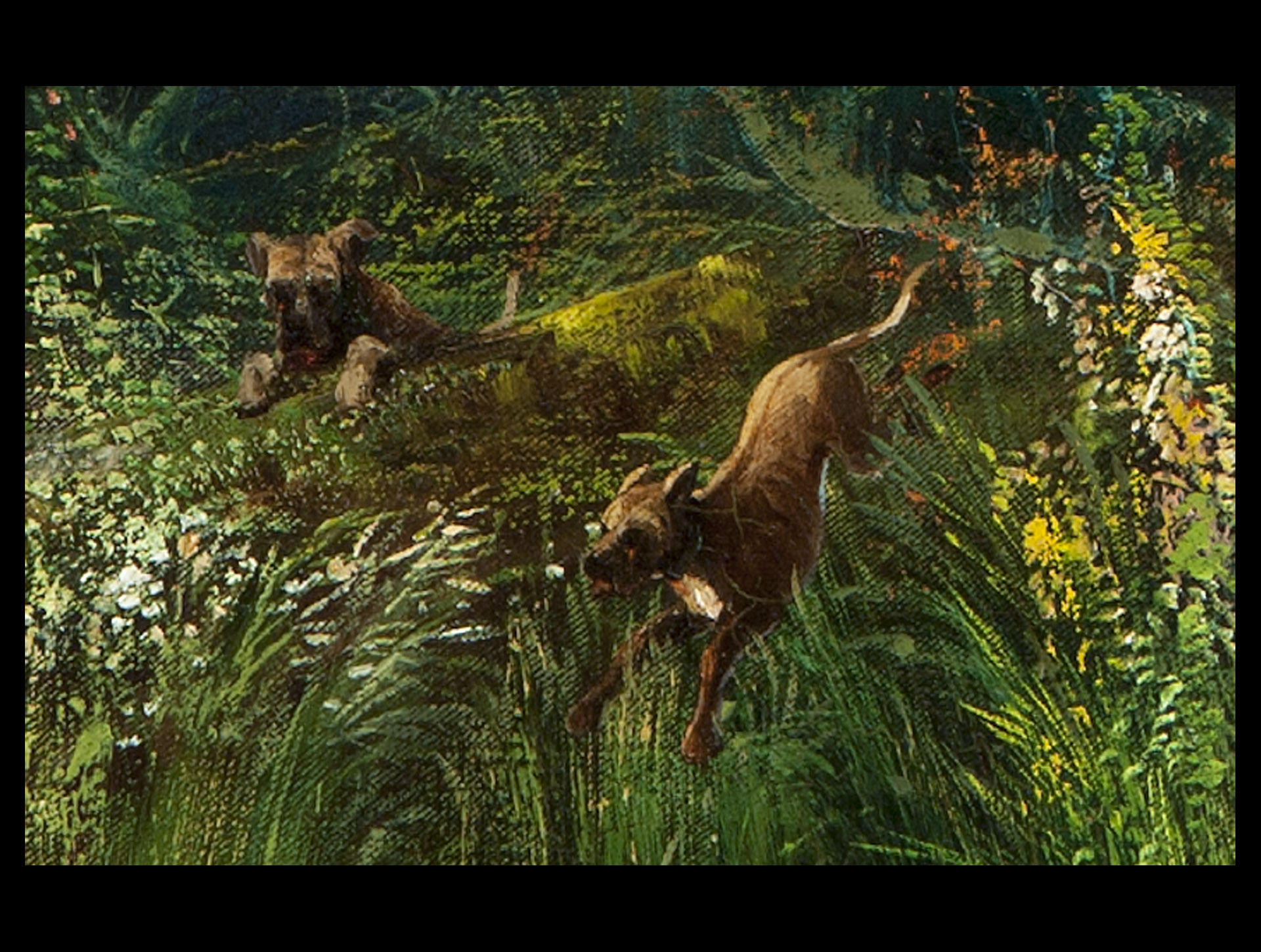
They were known in the circum-Atlantic slaveholding world as Cuban bloodhounds—known and feared. Specially trained to hunt runaways, during the nineteenth century these dogs became useful tools for capturing unruly “property,” essential weapons in the plantation’s carcelary order. Yet, to turn these creatures into vicious instruments for the domination and punishment of enslaved humans required inflicting cruelty upon the dogs themselves. Confined to narrow cages, fed sparingly, and beaten to fuel their aggression, the bloodhounds were transformed into protheses of the enslaver’s will to mastery.

Pictorial renderings of dogs’ role in runaway hunts offer some of the most enduring visual idioms of enslavement. Their uncanny historical echoes and re-embodiments stand as testaments to the centuries-old challenges to visualizing Black freedom.
Painted during the U.S. Civil War (1861-65), Thomas Moran’s monumental canvas, Slave Hunt, Dismal Swamp, Virginia (1862), depicts hounds chasing a runaway family through a hostile, spectral landscape in Virginia. Dismal was one of many swamps near Southern plantations that served as sites of escape and refuge, however inhospitable, for those desperately seeking freedom.
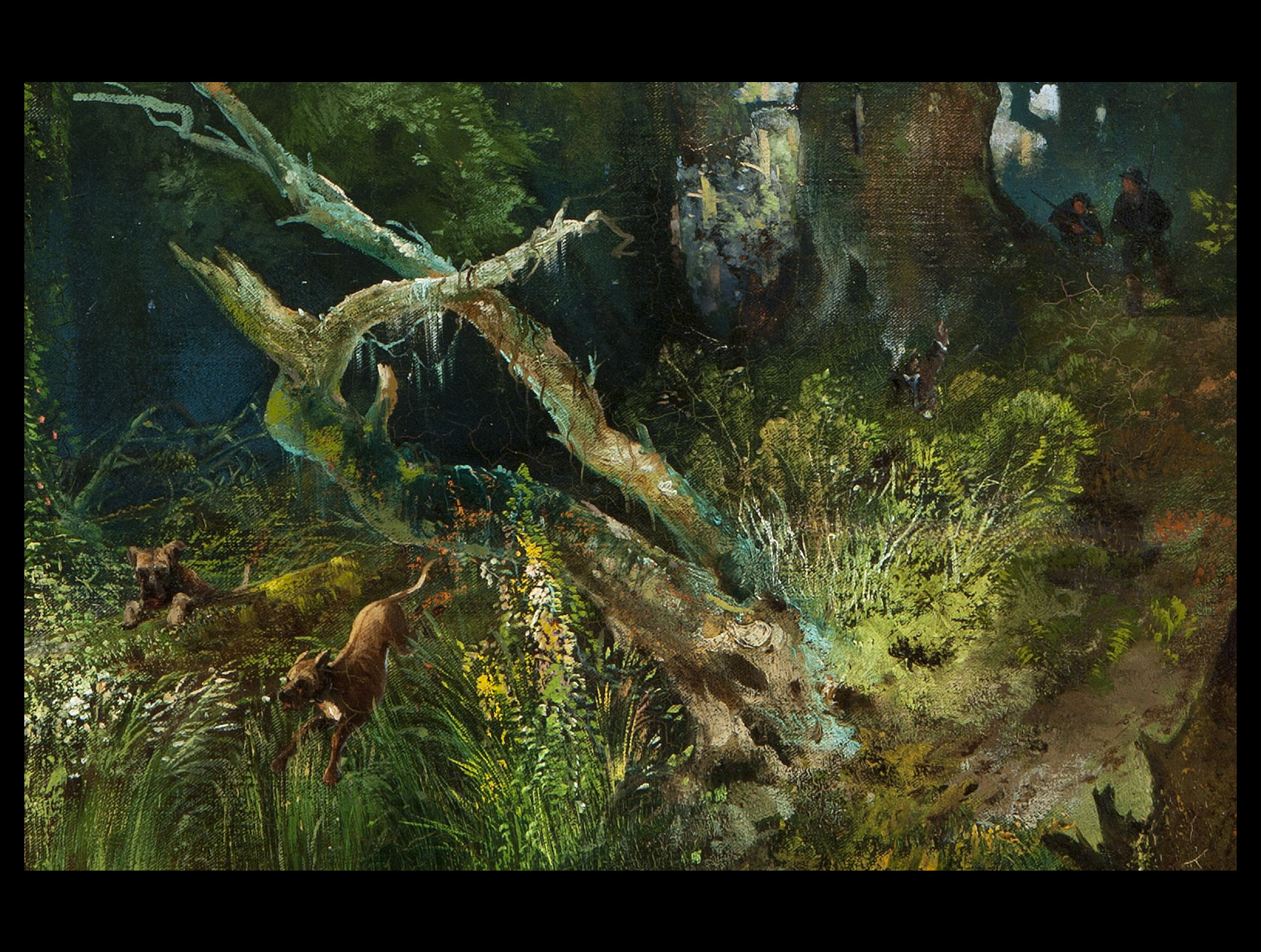
Here, the dogs—suspended at full leap and just before their mortal attack—provide the central fulcrum for the chase, which proceeds diagonally from the painting’s upper right to lower left. In the right background are the slave hunters, barely visible as dark, ghostly silhouettes next to a tree trunk. In Moran’s visual fabulation, dogs and hunters seem to merge with the earthy tones and shadowy overgrowth of the landscape, one in which nature seems to signify, and even collude with, the ominous magnitude of the mercenary plantation police.

By contrast, the only figures fully discernible at first glance are the criminalized runaway family. Evoking the Biblical flight from Egypt, their immediate identification is made possible by their brightly colored, if ragged, clothing, as well as the light that breaks through the dense tree canopy. The couple look back toward danger—the man with a resolute, protective gesture, and the terrified woman clutching their child tightly. Knife and stick in hand, the man stoically prepares for confrontation, yet his blood-stained weapons and the red-daubed object in the water nearby suggest recent combat and, perhaps, the killing of another dog. This liminal moment leaves viewers suspended in painful anticipation of more violence to come.
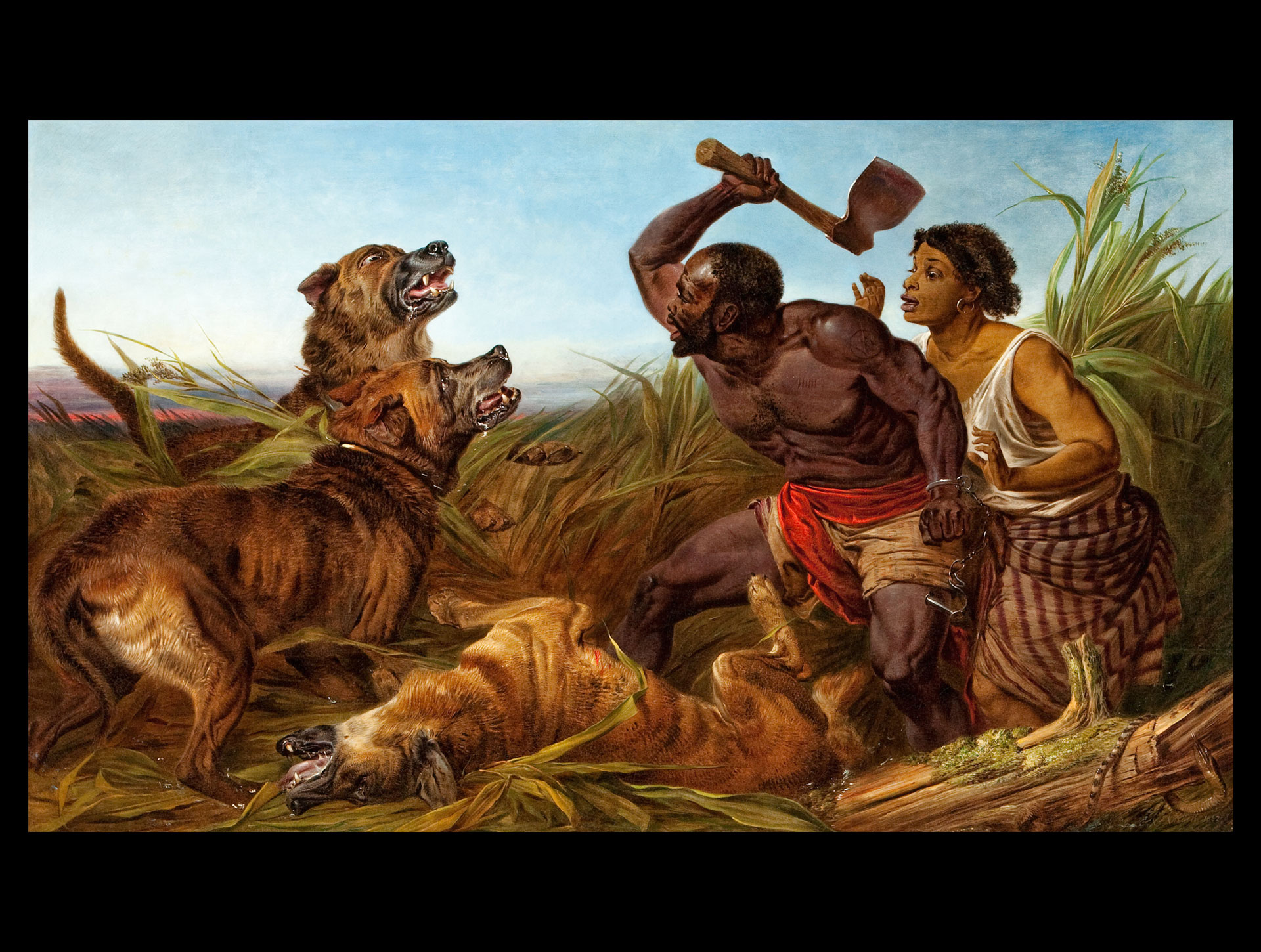
By the time of the U.S. Civil War, the use of dogs against enslaved people was an established target of critique for the movement to abolish slavery. Abolitionists saw it as a manifestation of the animal brutality of the slaveholding regime. Both Moran’s image and The Hunted Slaves (1861), painted by his contemporary Richard Ansdell, were part of anti-slavery campaigns. Unlike Moran’s, however, this image completely detaches the hounds from their human center of command and demands viewers focus on the spectacular bodily conflagration between enslaved and animal. The precise anatomical rendering of the figures underlines their common physicality, most evident in the well-delineated rib cages of the Black warrior and the ravenous beasts.

Compositionally, human and animal also mirror one another, but not as an analogy. The scene rather poses equivalences and identifications between the two. The ax wielded by the runaway, alongside clothing, is one of only a few elements that indexes the realm of human culture in a scene that otherwise conveys the dissolution of bodily borders between human and beast.
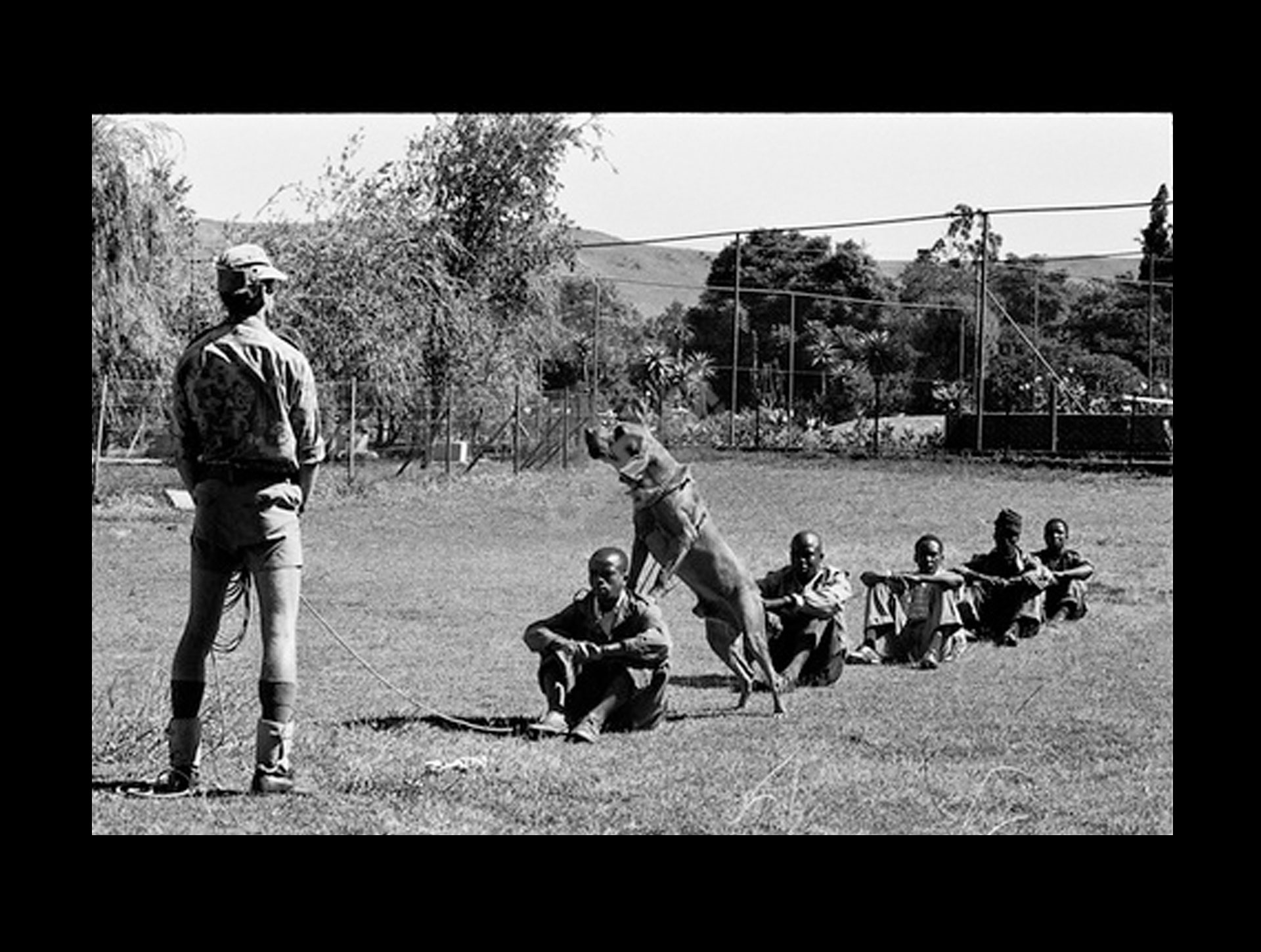
Images like Andsell’s occlude the social forces surrogated to dogs. They also render invisible the cultivation required to produce such savage instruments. With the specialized training of Cuban bloodhounds, dogs’ metamorphosis into weapons for racial and colonial domination began to acquire the status of a science, a sub-field of military and police science, in particular.
By 1911 the South African Police Dog Training Depot had become the world’s leading center for that task, one crucial for the control of Black lives under Apartheid and emulated by police departments in the United States and elsewhere. This later photograph portrays the supposedly rational efficiency of their schooling system: dog and trainer fully upright, mirroring one another, while exerting control over seated Black subjects.
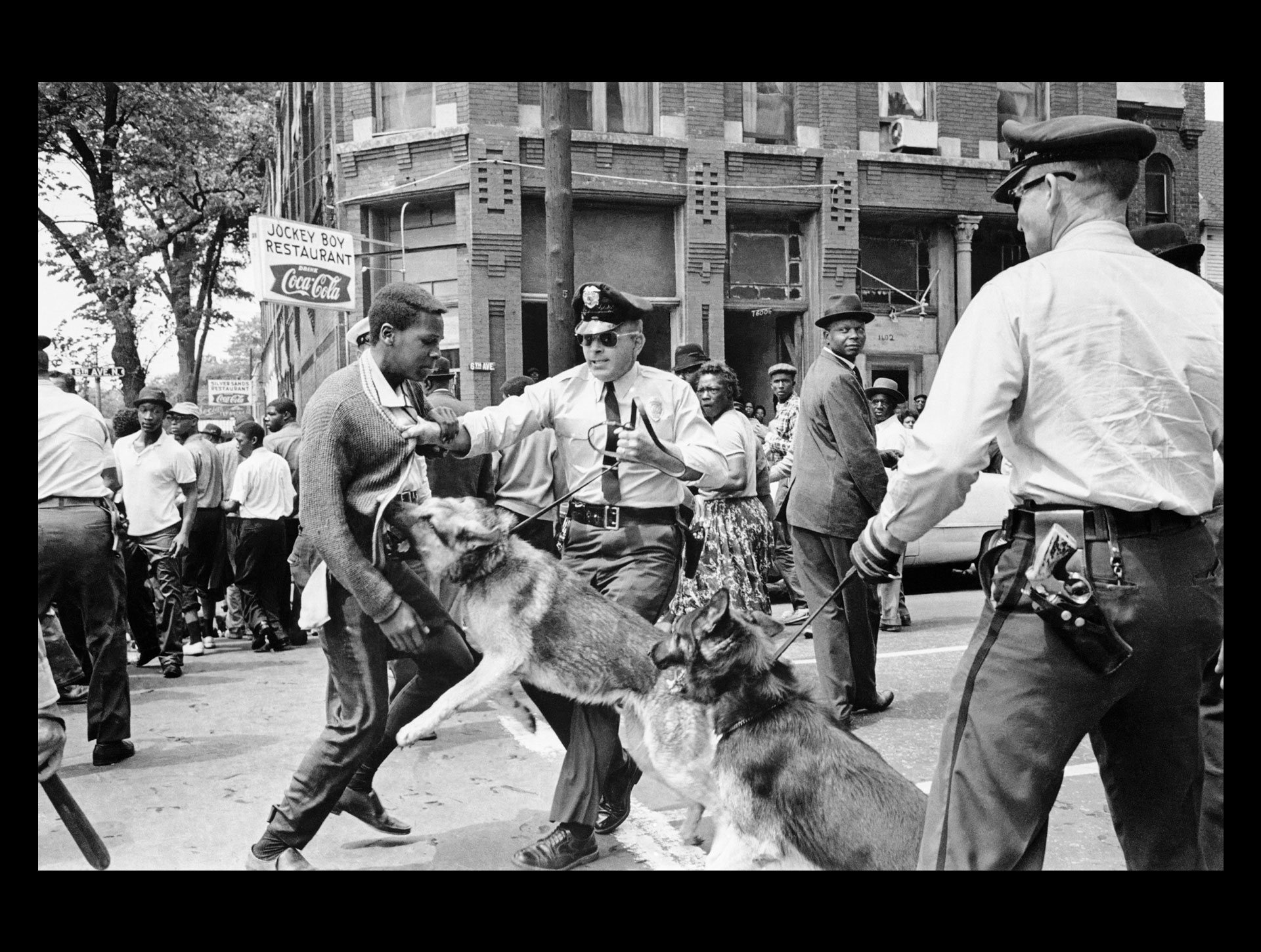
The visual entanglements of Blackness, policing, and dogs reached one if its most iconic moments in a memorable series of images taken during the Children’s Crusade of 1963 in Birmingham, Alabama. Considered a turning point in the U.S. Civil Rights Movement, this campaign, and the photographs of it by Bill Hudson and Charles Moore, became emblems of an obscene social order now made visible.
Here, 16-year-old Walter Gadsden is viciously attacked by a police dog. The animal trained to maintain a racist social order seems to have a will of its own. Despite the disciplined visual fictions of Apartheid dog training, it is precisely the unpredictability of the animal that ensures that the lawlessness of racist policing can never be kept entirely in check.

This time, though, and unlike Moran’s and Ansdell’s scenarios, the violence takes place under the watchful gaze of Black witnesses, whose concerned demeanor subtly suggests the possibility of community action yet to come.
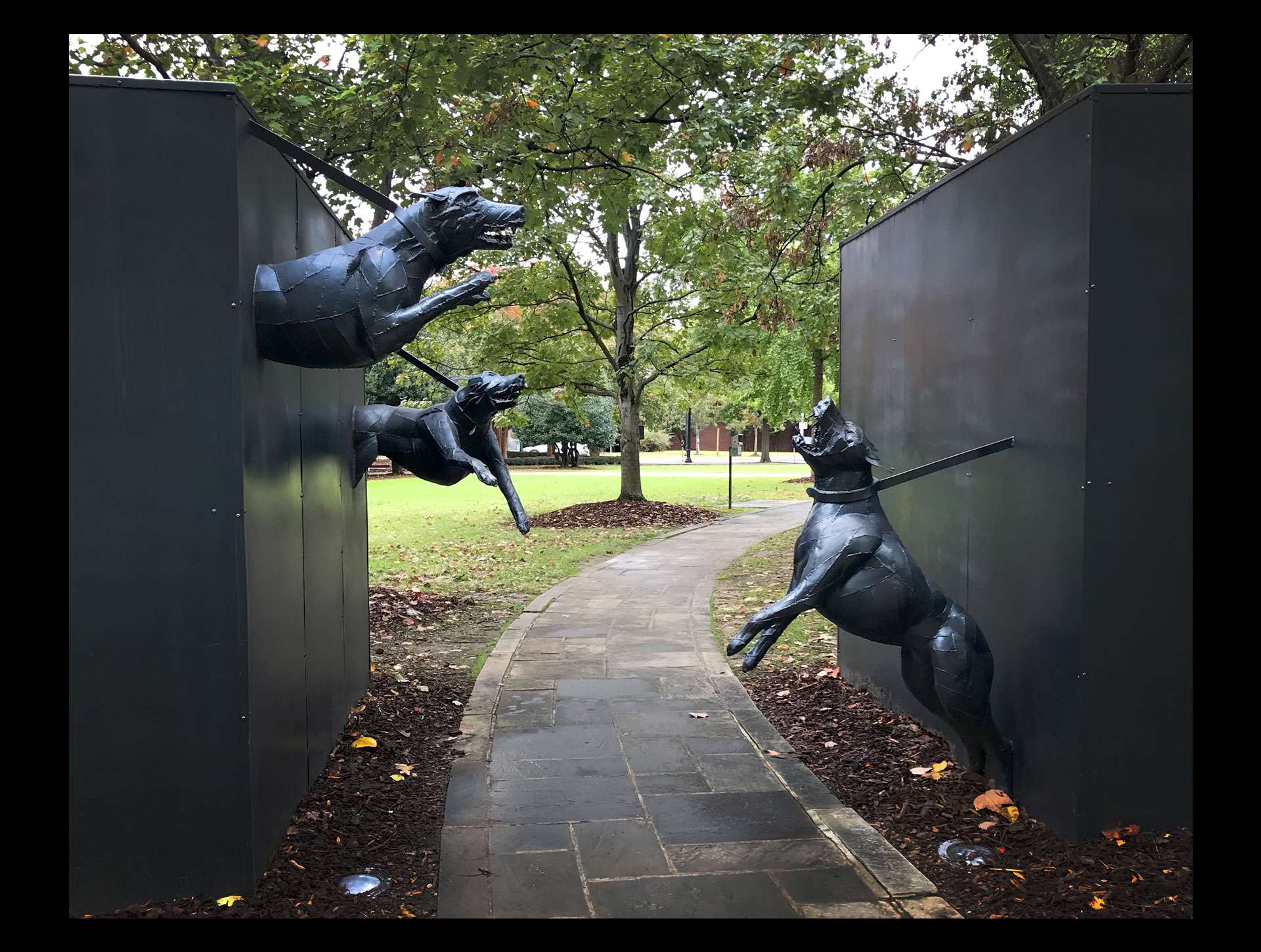
For the thirtieth anniversary of the Children’s Crusade, Birmingham transformed the area where the events occurred into a memorial park. The city commissioned the African American artist James Drake to create a sculptural program highlighting its most salient incidents. Rendered in realist forms, among the sculptures displayed is a figural group made of scrap iron that focuses solely on the animals, Police Dog Attack (1993). Its configuration invites viewers to navigate through them, as if under siege themselves.
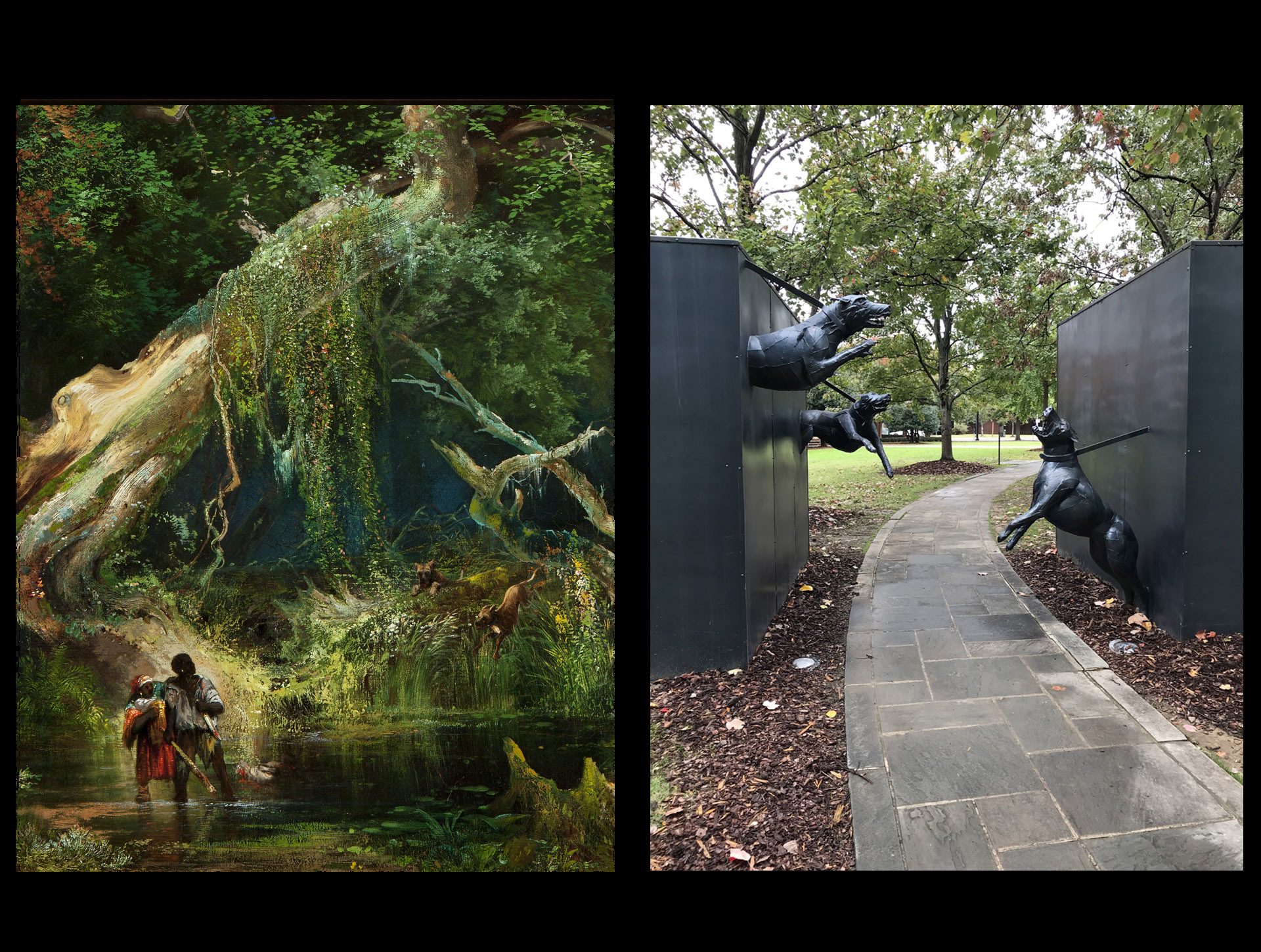
Significantly, rather than the German shepherds used by the police in 1963, the breed in Police Dog Attack resembles the hounds that so haunted enslaved subjects in the nineteenth century. Like a palimpsest, the sculpture evokes past visual images, such as the immobilized dogs, suspended in air, in the liminal moment portrayed by Moran. It also suggests moments after, in its future and our present, extending from Ferguson to Standing Rock and beyond. In the violent embodied afterlives of slavery, threats to the humanness of Black and racialized “others” continue to reverberate in the concealed bestiality of racist law and its displacement onto the animal. ■

Dogs
by Agnes Lugo-Ortiz
A palimpsest on policing, animality, and Blackness

They were known in the circum-Atlantic slaveholding world as Cuban bloodhounds—known and feared. Specially trained to hunt runaways, during the nineteenth century these dogs became useful tools for capturing unruly “property,” essential weapons in the plantation’s carcelary order. Yet, to turn these creatures into vicious instruments for the domination and punishment of enslaved humans required inflicting cruelty upon the dogs themselves. Confined to narrow cages, fed sparingly, and beaten to fuel their aggression, the bloodhounds were transformed into protheses of the enslaver’s will to mastery.

Pictorial renderings of dogs’ role in runaway hunts offer some of the most enduring visual idioms of enslavement. Their uncanny historical echoes and re-embodiments stand as testaments to the centuries-old challenges to visualizing Black freedom.
Painted during the U.S. Civil War (1861-65), Thomas Moran’s monumental canvas, Slave Hunt, Dismal Swamp, Virginia (1862), depicts hounds chasing a runaway family through a hostile, spectral landscape in Virginia. Dismal was one of many swamps near Southern plantations that served as sites of escape and refuge, however inhospitable, for those desperately seeking freedom.

Here, the dogs—suspended at full leap and just before their mortal attack—provide the central fulcrum for the chase, which proceeds diagonally from the painting’s upper right to lower left. In the right background are the slave hunters, barely visible as dark, ghostly silhouettes next to a tree trunk. In Moran’s visual fabulation, dogs and hunters seem to merge with the earthy tones and shadowy overgrowth of the landscape, one in which nature seems to signify, and even collude with, the ominous magnitude of the mercenary plantation police.

By contrast, the only figures fully discernible at first glance are the criminalized runaway family. Evoking the Biblical flight from Egypt, their immediate identification is made possible by their brightly colored, if ragged, clothing, as well as the light that breaks through the dense tree canopy, streaming into the space opened by the uprooted tree trunk that hovers above them. The couple look back toward danger—the man with a resolute, protective gesture, and the terrified woman clutching their child tightly. Knife and stick in hand, the man stoically prepares for confrontation, yet his blood-stained weapons and the red-daubed object in the water nearby suggest recent combat and, perhaps, the killing of another dog. This liminal moment leaves viewers suspended in painful anticipation of more violence to come.

By the time of the U.S. Civil War, the use of dogs against enslaved people was an established target of critique for the movement to abolish slavery. Abolitionists saw it as a manifestation of the animal brutality of the slaveholding regime. Both Moran’s image and The Hunted Slaves (1861), painted by his contemporary Richard Ansdell, were part of anti-slavery campaigns. Unlike Moran’s, however, this image completely detaches the hounds from their human center of command and demands viewers focus on the spectacular bodily conflagration between enslaved and animal. The precise anatomical rendering of the figures underlines their common physicality, most evident in the well-delineated rib cages of the Black warrior and the ravenous beasts.

Compositionally, human and animal also mirror one another, but not as an analogy. The scene rather poses equivalences and identifications between the two. The ax wielded by the runaway is one of only a few elements that indexes the realm of human culture in a scene that otherwise conveys the dissolution of bodily borders between human and beast.

Images like Andsell’s occlude the social forces surrogated to dogs. They also render invisible the cultivation required to produce such savage instruments. With the specialized training of Cuban bloodhounds, dogs’ metamorphosis into weapons for racial and colonial domination began to acquire the status of a science, a sub-field of military and police science, in particular.
By 1911 the South African Police Dog Training Depot had become the world’s leading center for that task, one crucial for the control of Black lives under Apartheid and emulated by police departments in the United States and elsewhere. This later photograph portrays the supposedly rational efficiency of their schooling system: dog and trainer fully upright, mirroring one another, while exerting control over seated Black subjects.

The visual entanglements of Blackness, policing, and dogs reached one if its most iconic moments in a memorable series of images taken during the Children’s Crusade of 1963 in Birmingham, Alabama. Considered a turning point in the U.S. Civil Rights Movement, this campaign, and the photographs of it by Bill Hudson and Charles Moore, became emblems of an obscene social order now made visible.
Here, 16-year-old Walter Gadsden is viciously attacked by a police dog. The animal trained to maintain a racist social order seems to have a will of its own. Despite the disciplined visual fictions of Apartheid dog training, it is precisely the unpredictability of the animal that ensures that the lawlessness of racist policing can never be kept entirely in check.

This time, though, and unlike Moran’s and Ansdell’s scenarios, the violence takes place under the watchful gaze of Black witnesses, whose concerned demeanor subtly suggests the possibility of community action yet to come.

For the thirtieth anniversary of the Children’s Crusade, Birmingham transformed the area where the events occurred into a memorial park. The city commissioned the African American artist James Drake to create a sculptural program highlighting its most salient incidents. Rendered in realist forms, among the sculptures displayed is a figural group made of scrap iron that focuses solely on the animals, Police Dog Attack (1993). Its configuration invites viewers to navigate through them, as if under siege themselves.

Significantly, rather than the German shepherds used by the police in 1963, the breed in Police Dog Attack resembles the hounds that so haunted enslaved subjects in the nineteenth century. Like a palimpsest, the sculpture evokes past visual images, such as the immobilized dogs, suspended in air, in the liminal moment portrayed by Moran. It also suggests moments after, in its future and our present, extending from Ferguson to Standing Rock and beyond. In the violent embodied afterlives of slavery, threats to the humanness of Black and racialized “others” continue to reverberate in the concealed bestiality of racist law and its displacement onto the animal. ■
< Return to Violence and Injury
< Return to Palimpsests
Referenced works
Thomas Moran, Slave Hunt, Dismal Swamp, Virginia, (1861-62). Oil on canvas, 86.4 × 111.8 cm. Philbrook Museum of Art.
Richard Ansdell, The Hunted Slaves, (1861). Oil on canvas, 184 x 308 cm. Walker Art Gallery, Liverpool.


